Cyberpunk 2020: Chromebook 1 by SirPhoebos
Gadgets
Original SA post
RPG supplements that just offer lists of new equipment walk a fine line. Some offer more of the same gear, with perhaps some added fluff about the economy of the setting. Much more often, these supplements provide equipment superior to what was found in the core book, breaking several important mechanics in the process.
Surprisingly, Cyberpunk 2.0.2.0.’s first equipment supplement, Chromebook, doesn’t have the powercreep that I remember. It’s still there, but it’s not to the same extent as later books. The first Chromebook makes up for lack of game-breaking items by just being very badly written.

The 4 Chromebooks for CP2020 each contain a wide variety of new equipment and other things to spend money on. They’re written as in-setting shopping catalogs. I have a pretty high tolerance for fluff writing on gear, as long as the rules to use these items are still present. Frequently, the stuff in Chromebook 1 fails to clear that bar.
I normally avoid going into who contributed to a book I review beyond the publisher. But apparently one of the contributors is reading this review as I post. To this person (and any others that later stumble on this review) I want to say “hi” and that I’m sure this was a valuable learning experience and that you went on to write a lot better stuff in the 30 years since this book. The book’s credits do break out which parts each person contributed to, but I won’t give the specific names, simply to avoid the possibility of some jerk connecting a real name with a forums’ ID.
Part 1: Gadgets
It’s probably a bad idea to start any book with a chapter that has “miscellaneous” in the title. While disheartening, it is accurate; the first section of Chromebook 1 contains personal (and non-personal) items that aren’t weapons, cyberware or vehicles. There are 41 items listed in this section The only items that rise above being miscellaneous are the cyberdecks. There are three of them for sale, and two of them are a lot cheaper than what the deck construction rules specify. However they aren’t cheap enough for a starting Netrunner to be able to purchase it and the cyberware and programs to use them. Two of the cyberdecks are hands-free - one being a helmet, the other built into a camo-suit. The third one comes with a fax machine!
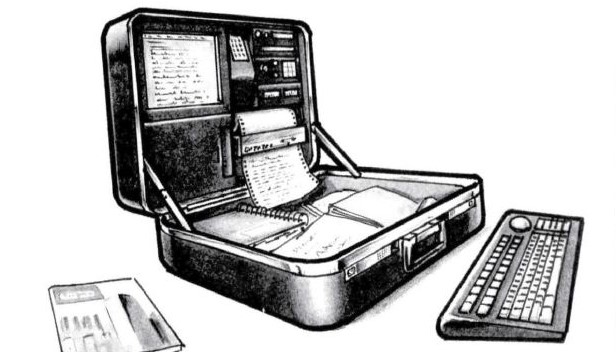

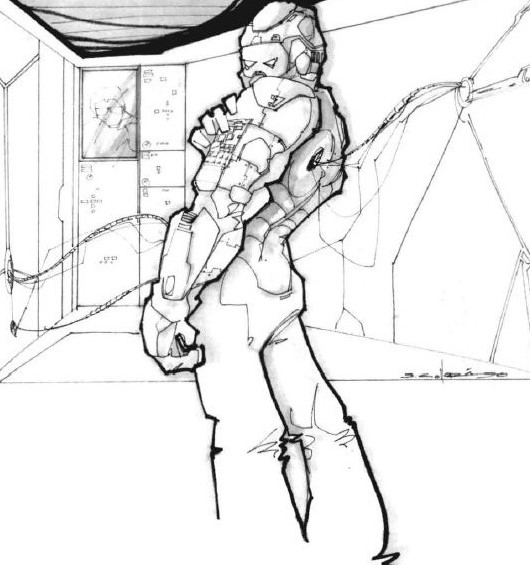
one of these things is not like the other
Speaking of which, there’s a lot of paleofuture items As an example, here’s what a Cyberpunk character would have to buy in order to get the same functionality of a real life smart phone:
- Cellular phone (core book): 400eb
- Pocket computer (aka a programmable calculator, core book): 100eb
- Digital camera (core book): 150eb
- Pocket TV (core book): 80eb
- Digital chip player (core book): 150eb
- Cab hailer: 150eb
- DataTel’s Mapmaker: 500eb
- Image wallet: 100eb
- Newsviewer: 100eb
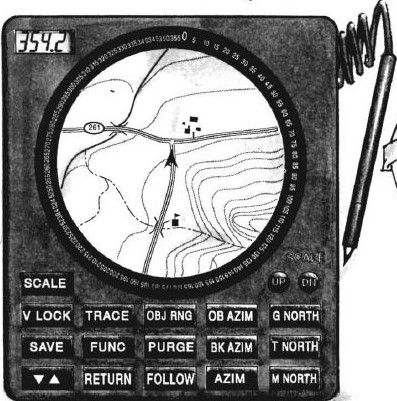
That’s 1730eb total. Meanwhile, I did a quick google check and as of 3/27/19, a Galaxy S9 costs $599.99 before any discounts.
Are there any ridiculous prices in the opposite direction? Well I won’t give too big a spoilers, but one of the sections in this supplement is Housing.
Aside from the cyberdecks, there are five items here that provide bonuses: DPI Smartsticks (+1 to Play Drums), Speedholster (+1 to Initiative when making a fast draw), Advanced Alarm Removal Kit (+1 to Electronic Security), the IR Combat Cloak (opponents get -5 to Notice if using IR) and the Digital Weapon Uplink (+2 to unjam a smartgun). That last one is notable because RAW you don’t need to make a skill check to unjam a weapon; it just takes 1d6 turns to do so. But the most useful item isn’t any of the above. Instead I would give that distinction to Detcord High Explosive. It costs 900eb for a pack of 10 meter high explosive wire that can cut through up to 40SP. This is the sort of item that has a lot of creative potential.
On the flip side, there’s gadget that feel like it was created after a player managed to short-circuit a Referee’s carefully prepared story. The Auto-Punchout makes non-Netrunners impervious to Anti-Personnel programs, but it carries a huge penalty that prevents actual Netrunners from using it themselves (-5 to Initiative).
Then there’s equipment that will almost never come up in a campaign, let alone be something players would actually buy. There’s a 1000eb Office Communication Suite, which is a Futuredesk (comes with a fax machine!) There’s a Digital Recording Studio that costs 12,000eb, which stood out to me because I remembered from the Rockerboy role description that the “advent of digital porta-studios and garage laser-disk mastering” was an important part of enabling Rockstars to operate independently of record studios. But so far all they got to make records is something that costs all their beginning funds. The diving suit from The Abyss is available for 6,000eb. Lastly there’s a suit of medieval armor available for 3,500eb, or 10,500eb for something really fancy. It’s stats are awful (SP 14, EV 6).

My award for “Most Useless Item” goes to the Power Grid Solar Electric Panel. It provides 110 EV on a sunny day. There are no rules for electricity usage in this game, but here’s a solar panel for 100eb, plus an extra 25eb if you want an extension cord.
Next Time: He Triiiiied To Kill Me With A Forklift, Òle!
Vehicles
Original SA post
Part 2: Vehicles
There’s one thing that I’ll give the Vehicle section is that the art matches the writing. Which is to say that it looks like it was drawn in the back of a grade-school notebook.
Not all of the problems here are the fault of the writer of this section. The core vehicles rules themselves are poorly written, and the stats for vehicles in the main book have to be pieced together from disparate information - and that’s when it’s actually available. To get full vehicle combat rules, a group has to use a 1st Edition supplement. It won’t be until Maximum Metal that the rules for vehicle combat and stats get updated.
With the excuses out of the way, it’s time to tear this trash apart.

The first vehicle is the Bensen Cascade, an “ultra fast sport hover”. It doesn’t fly, but it still floats off the ground a little. It’s difficult to control, which for other vehicles in CP2020 means there is a penalty to skill checks with this vehicle. The Cascade does things differently: a driver needs a Drive skill of 8 or higher in order to drive it. What happens if someone of lower skill tries to drive one?
 The Cascade has a top speed of 260mph, but no operating range is given. It has a limited autopilot that can make up to 10 turns. The Cascade can jump up to 3 meters to clear obstacles, but a Skill check of 20 is needed to avoid scraping the ground. Which either does nothing or will probably total the vehicle, depending on how you interpret the crashing rules. SP 12, SDP 40. Costs 58,000 eb.
The Cascade has a top speed of 260mph, but no operating range is given. It has a limited autopilot that can make up to 10 turns. The Cascade can jump up to 3 meters to clear obstacles, but a Skill check of 20 is needed to avoid scraping the ground. Which either does nothing or will probably total the vehicle, depending on how you interpret the crashing rules. SP 12, SDP 40. Costs 58,000 eb.The BMW 9018 is a hybrid limo/sports car. It has a top speed of 210 mph (no range), SP 24, SDP 90. It has space for six (unclear if that includes the driver). It cost 100,000 eb, and “it doesn’t have options, they ask you what you want, then they build it.” This is meant to be for luxury accoutrements (including a SegAtari cybergame system,
 ), but I’m sure some group tried to get as many heavy weapons onto a limo as possible for a flat cost.
), but I’m sure some group tried to get as many heavy weapons onto a limo as possible for a flat cost.The Harley-Davidson Thundergod is, well, a Harley. It costs 4,640 eb, and a cyberlink upgrade can be added for 950 eb. SDP 35, no armor. It has an operational range of 600 km, but no top speed. If you’re not going to put how fast a vehicle goes, then why bother?
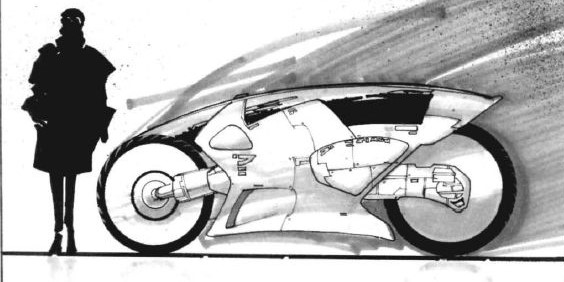
The Shiva is the first vehicle in this book to have full stats. (
 ) It’s got a top speed of 250 kph on city streets, but can go over 260 kph on a race track. No other vehicle has these two rating. The Shiva’s range is 400 km (gotta love flipping back and forth between metric and imperial) and has 35 SDP, no armor. It’s very maneuverable, so “reduce DIFF of all maneuvers by 5”. If only there was a more concise way to state this...benefit
) It’s got a top speed of 250 kph on city streets, but can go over 260 kph on a race track. No other vehicle has these two rating. The Shiva’s range is 400 km (gotta love flipping back and forth between metric and imperial) and has 35 SDP, no armor. It’s very maneuverable, so “reduce DIFF of all maneuvers by 5”. If only there was a more concise way to state this...benefit  There’s a warning against taking off too fast with a passenger in back, even though we have no rules for acceleration. Also, the drawing shows an enclosed motorbike. It costs 8,000 eb, and “interface plugs can be added easily”. No further explanation given (a vehicle price is normally doubled if it has a cyber interface).
There’s a warning against taking off too fast with a passenger in back, even though we have no rules for acceleration. Also, the drawing shows an enclosed motorbike. It costs 8,000 eb, and “interface plugs can be added easily”. No further explanation given (a vehicle price is normally doubled if it has a cyber interface).
The Pedicab is a partially motorized bike used for an ultra-cheap cab. (1.5 eb/mile. Heavy people pay extra). It can go 25 mph, down to 15 mph if fully loaded (no word on what that is). If going downhill it can go faster, and when properly motivated (such as by a gunfight), it can get to 30 mph. Pedicab drivers are “wonderful sources of information, if properly tipped”. A Pedicab has SDP 15, but there’s only a 75% gunfire will do only cosmetic damage (ie doesn’t actually protect rider or passenger). There’s no rules on how far the Pedicab can be ridden, but let’s be honest: this isn’t something players are going to be using for any extended length of period. The Pedicab costs 1,200 eb.
The Ambunaught is an ambulance. It also has no reason to exists because the game has Trauma Team AV-4s as a setting staple. I can only assume that a Referee didn’t think Aerodynes would have enough widespread availability, so there needed to be a ground alternative. But then we this line: “Next year’s model is supposed to float”. WE ALREADY HAVE FLYING AMBULANCES, STOP DOWNGRADING THE SETTING! Sorry The Ambunaught doesn’t even have any weapons for Kool-Aid Man entrances. It’s just an ambulance. It goes up to 72 mph on flat roads, 30 mph on rough terrain (no range), has 120 SDP and 40 SP. Costs 76,000 eb.
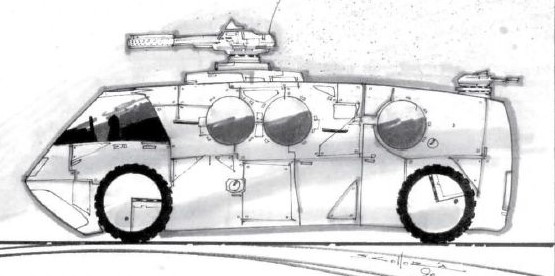
The Arasaka Riot-VIII is a riot van, available for rent to any government or corporation that needs a few extra boots. It has a crew of two and can carry 8 riot police. The Riot-VIII has a top speed of 120 mph (no range), SDP 200, and SP 30. The troops only have 75% coverage, which feels like a serious fucking design flaw. The Riot-VIII has two armaments. The first is a water cannon turret with a range of 30 meters (10 meters for steam), and it’s up to the Referee as to what it actually does so as to “keep them an unknown factor”. Thanks, book. The other weapon is a grenade launcher mounted on the cab (even though it’s drawn in the back) with a 300 meter range and carries 18 rounds. The Riot-VIII has a satellite uplink to let corporate boards micromanage riot police. It costs 250,000 eb, but there’s no information on what it costs to rent. Which was the main reason this vehicle is in the Chromebook.
To be clear, if this were a modern game, I wouldn’t care about stuff like whether a book specifies how far a vehicle goes or what it costs to rent one for a day. But when you have an old, granular RPG like Cyberpunk 2.0.2.0., and you write a supplement that has the conceit of being an in-setting advertising magazine, then you owe it to the reader to stick to that premise.
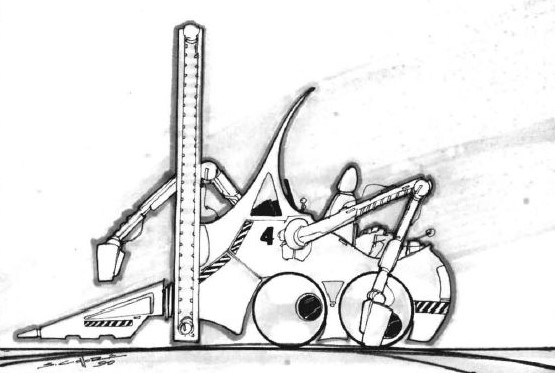
The GM Hyundai Worker Bee is an automated forklift, but it can also be manually operated. It has two robot arms to load and unload cargo. “They are found in those industrial facilities Cyberpunk PC’s are so fond of breaking into.” Top speed 25 mph, ? range, SDP 60 and SP 25. We’re told how much they can lift, but that’s not why anyone would use a Bee. What they’re going to do is attack someone with those arms. But we get no rules for how much damage they do.
 The bee costs 6,000 eb.
The bee costs 6,000 eb.Cyberpunk 2.0.2.0. doesn’t really know what to do with helicopters. On the one hand the setting has moved on to superior Aerodyne technology. But helicopters have a recognizability factor, especially when CP2020 wants to be Cyber-Vietnam. So we keep seeing helicopters presented as “budget options”. The Bell Spy-Eye 18 is a news helicopter. Although unarmed, it has defensive systems to avoid getting blown up. The Spy-Eye has a -30% vs missile hit. Top speed 280 mph, range ?, SDP 65, SP 12. “Maneuverability is high compared to other choppers (-2 from all maneuver rolls)”. The standard maneuverability modifier for Copters is 0, so I’m guessing this is some THAC0 type nonsense. The Spy Eye costs 206,000 eb.
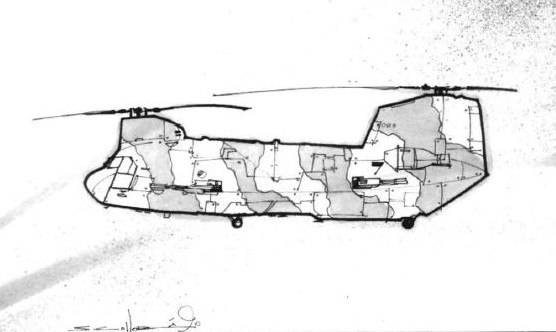
The Sikorsky-Mitsubishi Dragon is a (supposedly) heavily armored combat helicopter. How heavily armored? “Choose any 8 heavy weapons from the Solo of Fortune and Cyberpunk books to arm it.”

The heavy weapons in the core book are still man-portable weapons, like a single-shot missile launcher or a 20mm cannon that fires one bullet a round. And Solo of Fortune is a 1st edition supplement. Weapons in 1st edition normally didn’t list damage, instead you were supposed to look it up based on the type of ammunition used. The table for looking up damage wasn’t reprinted in CP2020, so a Referee has to piece together the damage for many of the heavy weapons. And for the few weapons that do have damage values, it’s immediately obvious that the way damage is determined changed between editions (damage in 1st edition decreased at longer range).
The Dragon has a top speed of 350 mph loaded and 420 mph unloaded, a range of ?, SDP 400, 90 SP. This would be a sheer headache to fight with personal arms (at least until the next Chromebook
 ). The Dragon doesn’t carry troops or cargo (despite being drawn like one). It costs 2.5 million eb.
). The Dragon doesn’t carry troops or cargo (despite being drawn like one). It costs 2.5 million eb.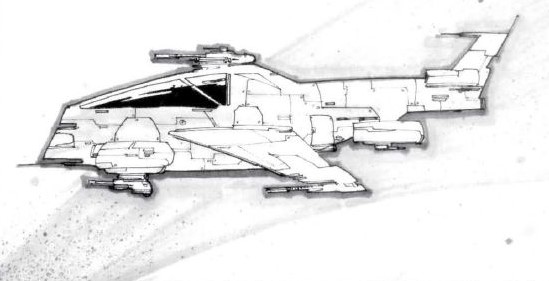
The AV-9 is a modular Aerodyne with three different suites that can be fitted in and out by crews between missions. There’s a command center (no idea what it does), a troop transport (doesn’t say how many troops it carries), and finally it has a gunship module. Unlike the Dragon, this entry actually lists what the AV-9 is armed with. Unfortunately, it doesn’t give a standard weapon stat block. Instead it tells us to look up a weapon from the core book but change a few stats. It’s hard to follow because important information is mixed with stuff not necessary to run combat. It’s also really unclear what comes with each module, because some weapons are part of the frame. The AV-9 has a top speed of 400 mph, range of 400 miles, SDP 180 and SP 45. It costs 1.3 Million.

The Punknaught are three to four AV engines, a bunch of guns, and a whole lot of scrap kit-bashed together into a makeshift armored vehicle. Construction takes “from a week to a month”. The Punknaught can fit 2 weapons per engine. “Each ‘unit’ has an SDP of 60 to 80”, implying this vehicle has separate hit locations. The parameters for creating a Punknaught are extremely vague, except that it’s entirely up to the Referee what the exact stats are - including weapons available. That restriction feels like a big kick in the junk for any Tech trying to play their role as advertised. I was going to complain about the book not even providing an example of a Punknaught, but after the last two entries, it’s probably for the best.
Next Time: Pull My Finger!
Cyberware
Original SA post
Part 3: Cyberware
Chromebook 1 adds 36 new Cyberware items to destroy your character’s soul with. Are any of them worth it?
The most universally useful is the Lifesaver Skinweave. Characters with this enhancement advance Death Levels once every four minutes as opposed to once every minutes. This greatly improves the odds of a Trauma Team saving a character that falls into a coma. It costs 4,500 eb, plus 1,000 eb in maintenance each time a character sustains a wound higher than critical. Even with the high cost, it’s a must-have for anyone that wants to do a long-term campaign. HC=(1d6/2)+1.
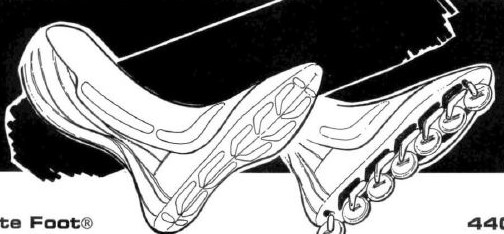
The Skate Foot is pretty useful for anyone that wants to be a melee combatant. It’s a heavy investment-not for the cyberlimb option itslef (440 eb, 1d6 HC each), but for the pair of cyberlegs. In return you get 20 MA, which means you can move 60 meters in a round. Having a pair of cyberlegs also synergizes well with kicking someone to death. The Skate Foot requires Skating or Athletics, but no actual skill check is required. Athletics is also used for throwing grenades so it’s not a waste. The one nitpick I have is that they screw up the conversion to mph.
There’s the Forked Tongue AudioVox implant that gives a +1 to Persuasion/Seduction rolls. It costs 350 eb and 2 HC, meaning it completely eclipses the Mr. Studd implant from the corebook. Finally, there’s the Wearman Mark II, because someone realized it was dumb to have Humanity Cost for purely decorative cyberware. The original Wearman was a cyberaudio option that let you listen to the radio or albums loaded from the chipware socket. The Mark II can be added without cyberaudio and has no Humanity Cost (it costs 200 eb, which is nothing).
So that’s four pieces of cyberware I would recommend at some level. As for the rest...
There’s a cyberhand, which just replaces the hand instead of the whole arm. It costs 750 eb and 1d6 HC. The cyberhand can have one arm option or 4 finger options. That brings us to the cyberfingers. These are fun little tools, but since each one chips away at a character’s Humanity, they’re less likely to be bought instead of something that provides a greater overall benefit like hydraulic rams.
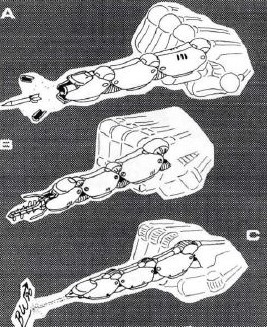
There are a few cyber weapons that range from pathetic to ‘will be used once for great effect and then everyone will take the defense against it’. On the pathetic end, we got the Derringer cyberhand option that I swear sounds like something straight out of Ninjas and Superspies. There’s a Cyberwhip that can be used to strangle opponents, but it leaves the attacker exposed and also with no way to get away if they need to. The Mace Hand actually has a reasonable HC cost (3) and does decent damage, but the modified hand has -2 to REF checks, which I assume includes attacks with the hand itself. The Gang Jazzler can immobilize an opponent for minutes if not outright kill in one hit, but once it’s used everyone is going to be getting Skinweave (it can’t affect armor higher than 3). The Flashbulb is a high strobe light installed in the base of a cyberarm palm and can stun a group of people for 1d6 minutes. Afterwards everyone is going to include anti-dazzle in their cyberoptics or goggles. There’s even an Optishields add on that explicitly has anti-dazzle included.

There are two enhanced versions of the TimesSquare Marquee cybereye option. There’s be an increased number of cybernetics that need some version of the TimesSquare to function, which just make me feel that it should have been a standard feature for cybereyes. There are three cyberware specifically for coping with outer space. As of this supplement, you had to go to a 1st edition book to get the base rules for outer space (Low Orbital).
There are a couple of upgrades with really situational bonuses. One is the Pacesetter and Pacesetter 2000. These boost the character’s MA and BODY Stats by 1 and 2, respectively. Except for BTM and Death Save, which are the stats most characters care about. In fact there’s a Death Save penalty while using these. The other benefits from having those stats are are marginal. The Pacesetters have penalties for prolonged use, but combat won’t last long enough for these to matter. The Pacesetter 2000 is strictly better than the Pacesetter, and doesn’t even have a higher HC cost.
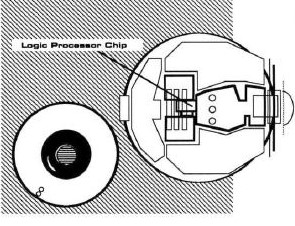
I need to give a mention to the Dodgeball cyberoptic upgrade. It’s like Targeting Scope but for Melee, giving the user +1 to Martial Arts, Brawling or Melee. There’s just one problem: in order to get the bonus, the user has to observe his opponent for thirty seconds, or 10 combat rounds. That’s an insane amount of time for combat to last.
My pick for worst cyberware is LimbLink. One of the cyberarm options in the corebook is a pop-up gun. One would assume that if the same character had a Smartgun interface, the pop-up gun would get that benefit by default. Chromebook 1 thinks otherwise. The LimbLink gives the pop-up gun the +1 smart gun bonus. It costs 100 eb, 1 HC, and one of the four cyberlimb option slots. This is just a needless tax on characters that really want a gun to pop out of their arm. And it’s a cost that didn’t exist until this book.
Oh, all of the cyberware in this book are missing Surgery Codes. Because who needs complete rules?
Next Time: They just made it bigger
Weapons
Original SA post
Part 4: Weapons
The Weapons section of Chromebook 1 has the worst art in the book. As sloppy as the vehicles were, they at least had an earnestness to them that I found charming. By comparison, most of the drawings here are of plain looking guns in flat (sometimes 3/4) profile. Most look like they’re traces right out of a Guns & Ammo magazine, and the weapons that aren’t are from movies or look like toys.
The statblocks for the weapons in Chromebook 1 are missing the range. This is huge because base difficulty to hit is based on range. For standard weapons it can be assumed it has the normal range of weapons in its class, but there are enough specialized weapons where it’s harder to make a comparison. Some weapons do have ranges given in the descriptions, which can greatly change how effective it is.
There are 34 weapons in this section. My first question while reading this is if there were any that Jamie, my sample character from the core review, would purchase. Specifically, would there be something she would buy at character creation? At first I didn’t think I would find anything, but after a final reread before typing this update out, I found a new gun for Jamie:

The Heckler & Kosh G-6 Advanced Squad Automatic has a similar stat block as the Sternmeyer CG-13. 5d6 damage and +1 Accuracy is the same. 100 Rounds and 30 ROF is honestly more manageable than the 90/48 of the CG-13. There’s one big difference in the (incomplete) statblock, and that is that the G-6 is a Light Machine Gun. So the Heavy Weapons Skill would be used for attacks, which isn’t a career skill for the Solo. Jamie would have to spend pick-up skill points to max out Heavy Weapons, but that frees up the career skill points she used for Rifle on stuff like Notice and Stealth. And Heavy Weapons opens the door to a lot of weapon, so having an effective anti-personnel weapon on top of the big hitters is huge. The description text makes the G-6 even better. The range is 900 meters, more than double that of rifles. It comes with smart gun interface included. And SP from armor is halved, but the damage that gets through does the normal amount. The H&K G-6 costs 2,050 eb, a little less than a smart-linked CG-13. And I thought I’d have to wait until Chromebook 2 to break the damage curve further.
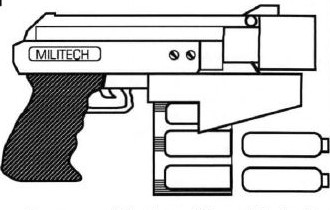
Another weapon that Jamie would pick up is the Militech Mini-Grenade Launcher. This is one of the weapons where it’s not clear what the range should be, but the closest equivalent is the normal grenade launcher in the core book (225 m). The mini-grenade launcher comes in two versions. One is a stand-alone weapon that carries 16 grenades (pictured). The other is an under-barrel addon that holds 4 grenades. Jamie will be getting the under-barrel version (255 eb). Grenade launchers use the Heavy Weapon Skill. The benefit of the mini-grenade launcher is the flexibility of munition types. HEP grenades do 5d6 (1/2 real damage, 1/2 stun, armor has no effect and is damaged two levels). Fragmentation grenades do 2d6+1 in a 5m diameter. Flechette grenades hit with 2d6 shards, each doing 1d6 damage. It can also shoot smoke or tear gas.
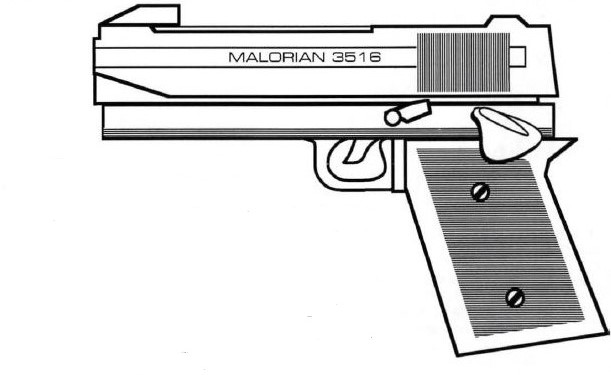
The last weapon on Jamie’s shopping list is the Malorian Arms 3516. It’s also called the Silverhand Special because it was a custom order from the setting’s favorite office-trashing Rockerboy. The 3516 straight up breaks the damage scale for handguns. The hardest-hitting handguns in the corebook do 4d6+1 damage. The Malorian 3516 does 6d6. It requires a Cyberarm to use, but later books would say that this requirement can be ignored by characters with a BOD of 12. The Malorian 3516 costs 4,525 eb and comes with a smartgun link. While it’s not something Jamie will start with, she’s going to get one after completing a few missions.

There’s one other weapon in Chromebook worth talking about, and that’s just because CP2020 left a genre staple out of the core book. Y’see, because there are no rules for modifying weapons, there’s no sawed-off shotgun in the core book. The Militech Crusher SSG lets a character just purchase one. It’s a little weak compared to the shotguns in the core, but it's a shotgun you can conceal it in your jacket.
The 30 other weapons are bad in varying degrees. There are a couple of weapons that’ll be really good once, and afterwards everyone is going to have the counter to it. The EMP grenade will have everyone buying the electric hardening options for everything (and make the Referee come up with prices for things that don’t). The Biotech-Askari Motion Restraint is a bomb that explodes into a polymer net that seemed like a good option for non-lethal takedown, until I realized that the Release Tube can be bought seperately. At least it has the benefit of being really inexpensive.
There are a few weapons that suffer from the incomplete rules. The Rostovic Wrist Racete has no range, and you have to go digging through the cybernetics section of the core book to find something that’s comparable. That’s not as bad as the Rifle Grenade. There’s an anti-tank variant, but your guess is as good as mine as to how much damage it does! There are three guns that fire flechette rounds. Two of the guns have extremely different rules on how flechette bullets work. The third simply doesn’t list any damage.
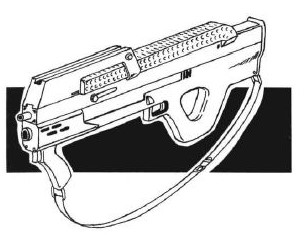
Then there’s the Militech M-31a1. It’s literally the rifle from Aliens. It’s actually halfway decent. It has +2 accuracy, carries 150 rounds and comes with the mini-grenade launcher. But it does low damage for an assault rifle (4d6). It’s also really expensive for a rifle that doesn’t include a smartgun link (1,695 eb). When compared to other rifles, my impression is that all you’re paying for is just a really big ammo clip.
My award for worst addition is split between 11 different weapons in this section that are effectively identical to the guns found in the core book. There are slight differences in ammo capacity, accuracy and/or cost, but they bring absolutely nothing new to the table. The core book already has two SMGs that do 2d6+1 damage, this supplement didn’t have to waste a half a page to tell me about another one!
Next Time: Dressing Down
Fashion, Services & Housing
Original SA post
Part 5: Fashion, Services & Housing
I am admittedly of two minds about this section. On the one hand, the rules for clothing, if players want to spend money on it, are pretty damn simple from the core book: Pick the item of clothing then give it a multiplier depending on how fashionable it is. So having individual clothing lines with separate prices for every article of clothing is pretty pointless. But I can appreciate the extra effort to give some variety to how people in Cyberpunk 2.0.2.0. dress. In the core book we’ve seen a lot of leather jackets, tank tops, trench coats, or suits that would be hard to tell was “future fashion” if not for the bits of cyberware also present. So it’s nice to get some alternative looks for what someone might wear.



I have very little to say about this section...except that even here they manage to break the item scaling. See, the max SP you could get without taking EV penalties (outside of the head) was 14. But in Chromebook 1 we get armor that provides 16 or 18 SP with no EV. It’s not huge, but 4 points of extra SP can mean the difference between some attacks getting through or not.



Since that was a short chapter, I’ll cover the next section of Chromebook 1: Services. There are a few interesting ones. Character can rent an AV-4 for 500 eb an hour and only need to put down a 500 eb deposit. That seems like a surefire way for the service provider to go bankrupt, but whatever. There’s a Bug Sweeper service so characters don’t have to go through the hassle of checking their apartments every goddamn time. The laundry service also doubles as armor repair if you are using the degradation rule. There’s a detective agency if the group is really not into doing investigation. Finally, there’s an executive decorum service that could probably be used to somewhat short-circuit the bad skill progression rules, but it still takes six months to give +2 to Social Skill, so it’s probably only worth it if your Social is at 8. Other than that these services can serve as inspiration for one-shot adventure hook (get hired to retrieve a Corporate’s pet howler monkey, for example).
Well this is still a short update, so let’s move on to the last section of miscellaneous stuff: housing. There are five examples of housing in this section, and each is laid out in the same fashion: an in-setting advertisement, base price, Referee information, and a floor plan. The preface at the beginning at least makes it clear that PCs aren’t so much meant to spend money on this, but these would be locations for different scenarios. The first entry is an Arasaka Sleep Facility. It’s a capsule hotel for the inner cities, and it’s as disgusting and dangerous as you would imagine. Characters might come here to meet a Fixer or a fly-by-night Ripperdoc. What’s not mentioned at all is that it’s strange or suspicious that a security Megacorp known for black-ops shenanigans is running a chain of roach motels. Today I can think of a bunch of plot hooks that would tie into these places, but a reader less immersed in in the Cyberpunk genre probably won’t see this potential. Costs 40eb/night + a whole bunch of side charges of varying degrees of usefulness.

Security Services, Inc. Professional Apartments are single bedroom apartments for junior to mid-level Corporates or other high-value employees. They cost 2,500 eb a month, but an executive will probably have free housing as part of their lifetime contract. Chromebook expects PCs will be breaking into these apartments, so most of the details are focused on security. In particular the security system for the apartment is offline, so it can’t be compromised by a Netrunner. Dick move, Chromebook! I’ve ragged a lot on how Netrunning sucks, but if a group is going to have a Netrunner, then let them do their thing. Cockblocking an entire role does nothing to fix its core issues. And for what? This is some mid-level yuppie the players are going after, not someone important.
Speaking of which, the next living quarter is The Masterpiece, a Harris & Company Luxury Penthouse on the top of a high-rise in downtown San Francisco. Two floors with outdoor patio and AV-Pad. Private elevator. Sophisticated security systems inside and sentry turrets on the outdoor areas (though no blanket immunity to hacking, amusingly.) The penthouse or one like it is an appropriate spot to have as the climax of a campaign, or perhaps something the group can get for themselves after a really big score. The opening bid for this penthouse is 800,000 eb. Umm, I’ve never had the money to buy a permanent residence, but that feels really low for what the buyer gets and where it’s located. Sure it’s a bid, but the architects faces a real risk of the bidders getting together to low-ball them.
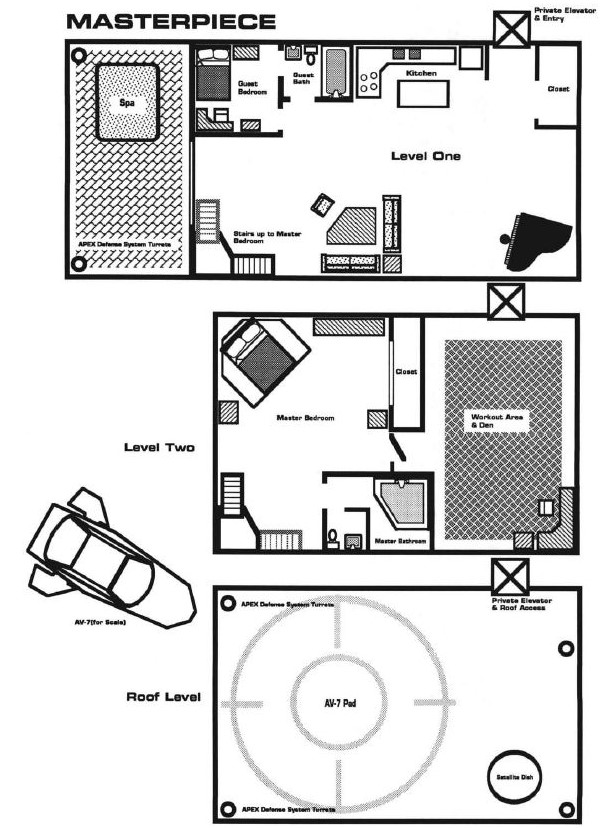
Silverhand Studios are a collection of warehouses across the country that have been converted into communal lofts. Costs 600 eb a month, and there’s side benefits for being part of an artist commune. Other residents can help characters find work or lay low when the heat is too hot. Just living in the studios for a year will boost an artistic skill by +1 (up to +3).
Finally there’s the Drifter RV. It costs 24,995 eb, but the seller, New American Motors, offers “the lowest finance rates (22.5%).” Please don’t make the Referee calculate financing rates, Chromebook, just give a per month price and move on! The Drifter keeps up the trend from the vehicle section of leaving out important stats. In this case, we don’t the vehicle’s top speed. Lovely.
Next Time: Chips and Dipshits
Chipware & Programs
Original SA post
Part 6: Chipware & Programs

The chipwre socket is my favorite piece of cyberware from a design standpoint because of their flexible nature. Even with just the core book it provides a way to get around the bloated skill list (of course the real solution is not to have 90+ skills to begin with, but it was the 80s, give some slack). Chromebook 1 adds a slew of Biofeedback chips that have benefits beyond just simple skill bonuses. Of course, some of them are more useful or better written than others.
One chip that is badly written but still manages to be useful is the Adrenaline/Endorphin Surge. The chip allows you to ignore exhaustion for up to 48 hours, and during this time “skill penalties due to wounds can be ignored”. Which seems great, except that damage penalizes a characters stats, not their skills. Whoops! While an easy fix it leaves the door open for a Referee to be an asshole. At least the second benefit is better written. Up to three times while the chip is active, the user can boost their BOD stat by 1 for a minute, increasing BTM and Stun Saves.
The other good Biofeedback chip is the Stress Chip. The most important benefit is that it gives +1 EMP “while using human interaction skills”, which I’m pretty sure is all the EMP skills. While getting all the cyberware installed to use this chip has a chance of costing a EMP, a social-focused character will probably be bugging the Referee about the therapy rules. Even if they don’t, this chip basically reverses the damage and let’s the character take advantage of other chipware. The other benefit of the Stress Chip is it gives a +1 bonus to COOL for the purposes of combat morale. But as I noted in my review of the core book, COOL only comes up once in combat.
In contrast, the Increased Neural Feedback Chip is the worst chip in this book for metagame reasons. See, characters can’t just insert a REF-based skill chip and suddenly know Kung-Fu. The user has to practice for two days per +1 skill the chip gives. However this rule is hidden in the lengthy description of chipware in the core book, so most groups (and even published adventures) ignored this rule so that characters could, say, know how to scuba-dive when a scene called for scuba-diving. This chip not only brings the practice rules to a group’s attention, but then doesn’t even provide a good enough solution and are themselves useless. The INFC chips don’t allow for instant knowledge of REF skills, it just reduces the learning time by 1/2. But these chips burnout after 24 hours of use-which is the time it would take to learn the chip!
One new type of chip is Memory-Compression chips that provide a suite of skills instead of just one. The maximum of the skill suite can’t exceed +3. Depending on the skill and the character’s stat this could be useful, but more likely it’ll be better to get one chip with the necessary skill at +3. One new skill is introduced here called Culture, and the rules for it are very badly written. “Without this skill, a character will have a +2 on other EMP based rolls when dealing with an NPC from another country”. So, not having the skill gives you a bonus? I'm sure that's not what they meant, but that's what ended up in print.
Finally, there are a bunch of Visual Recognition chips that are dependent on the TimesSquare Plus upgrade from the Cybernetics section (which wouldn’t be so annoying if not for the fact that it took up 3 of the 4 upgrades.) One thing I hate about these chips is that in order to use them effectively, a character also needs to have the relevant Expert skill (or Specific Knowledge, which isn’t a thing in CP2020). So rather than reduce the problems of skill bloat, these chips just increase them. Great.
One last chip worth mentioning is the M.O. chip, which help the user spot and identify, well, a criminal’s M.O. Only there’s a risk that when you use the chip, you start thinking that you are the criminal. Because that’s just what players needed, opportunities to lose control of their characters.

The last section in this book is Cyberdeck Programs. A lot of these programs are attributed to a Netrunner named Waycon Kid, who I assume is the contributor’s character. These programs are mix of redundant and terrible, but there are a few that stand out. First there’s Vampyre II, a Demon/Anti-IC program that adds programs it kills to its subprogram suite, except there’s a chance every time it uses the subprogram it crashes. Then there’s Bunnies, a program that does nothing except counter Vampye II. Lovely. Then there’s Psychodrome, an Anti-Personnel program that makes the targeted Netrunner too afraid to get on the net until they succeed a COOL check that can be made once a day. Hooray for crippling characters!
Finally, there’s Fatal Attractor, which I will quote the description:
Chromebook 1 posted:
A particularly nasty version of Hellhound credited to the infamous Waycon Kidd. Legend has it, the Kidd ended up as the loser in a romantic triangle, and used this duplicate of his ex-girlfriend to eliminate his netrunning rival.
The Fatal Attractor operates much like a Hellhound; it lurks around Data Fortresses waiting to pounce on intruders. However, instead of immediately attacking, it appears as a very attractive female netrunner who offers to help the intruder break into the system. The Fatal Attractor will cheerfully accompany the ‘runner for 1D6+1 turns, then attacks as a Hellhound.
There are not enough emotes to express my disgust.
Final Thoughts
Overall, the first Chromebook is pretty forgettable. It adds some interesting items, but nothing here is going to greatly alter what a Cyberpunk campaign will be like. The only things that get referenced by other material are the cyberfingers, the TimesSquare Plus, and the Malorian 3516 (also the Punknaught made it into an adventure in Challenge Magezine). And while the 3516 is very good, I wouldn’t say that it’s busted. It’s still a pistol, meaning it has a relatively low range, and it can only fire once a round. And while it does more damage than any other pistol, it’s comparable to the heavy rifles in the core book.
While this supplement was mostly unremarkable, it’s necessary to get it out of the way so we can get to the supplement that really fucks with everything. Strap in Choombas, because the next issue of Chromebook is hitting the Data Terms!